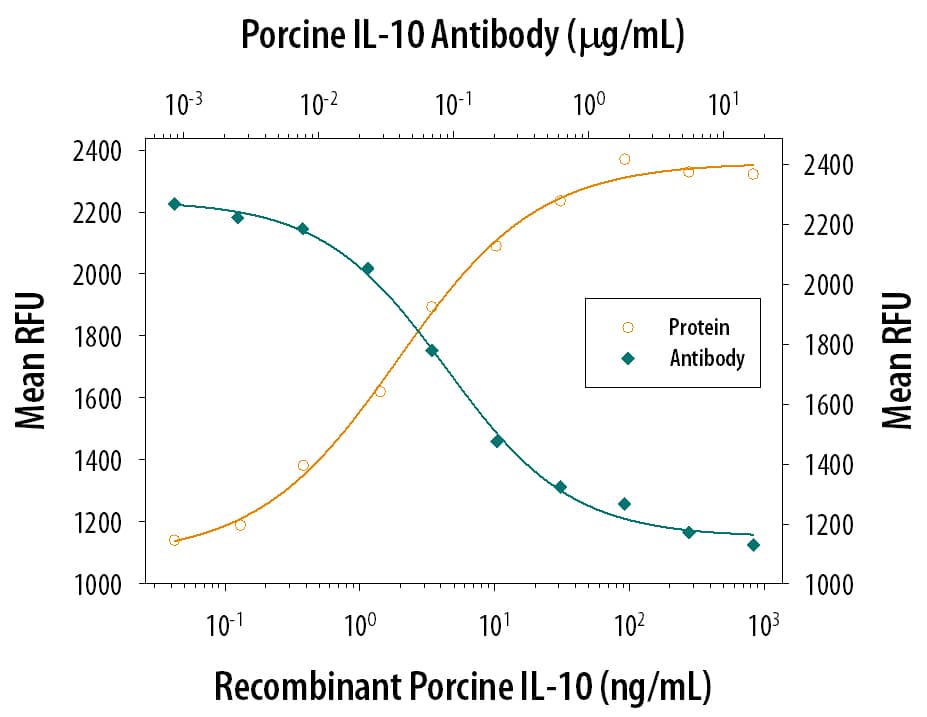Porcine IL-10 Antibody
R&D Systems, part of Bio-Techne | Catalog # MAB6931

Key Product Details
Species Reactivity
Validated:
Cited:
Applications
Validated:
Cited:
Label
Antibody Source
Product Specifications
Immunogen
Ser19-Asn175
Accession # Q29055
Specificity
Clonality
Host
Isotype
Endotoxin Level
Scientific Data Images for Porcine IL-10 Antibody
Cell Proliferation Induced by IL‑10 and Neutralization by Porcine IL‑10 Antibody.
Recombinant Porcine IL-10 (Catalog # 693-PI) stimulates proliferation in the MC/9-2 mouse mast cell line in a dose-dependent manner (orange line). Proliferation elicited by Recombinant Porcine IL-10 (40 ng/mL) is neutralized (green line) by increasing concentrations of Mouse Anti-Porcine IL-10 Mono-clonal Antibody (Catalog # MAB6931). The ND50 is typically 0.05-0.15 µg/mL.Applications for Porcine IL-10 Antibody
Neutralization
Formulation, Preparation, and Storage
Purification
Reconstitution
Formulation
Shipping
Stability & Storage
- 12 months from date of receipt, -20 to -70 °C as supplied.
- 1 month, 2 to 8 °C under sterile conditions after reconstitution.
- 6 months, -20 to -70 °C under sterile conditions after reconstitution.
Background: IL-10
IL-10, initially designated cytokine synthesis inhibitory factor (CSIF), was originally identified as a product of murine T helper 2 (Th2) clones that inhibited the cytokine production by Th1 clones which are dependent upon stimulation with antigen in the presence of antigen presenting cells (APC). Murine IL-10 is produced by Th2 cells, activated fetal thymocytes, macrophages, keratinocytes, and LY-1+ (CD5+) and normal B cells. Human IL-10 has cross-species actvities and is active on mouse cells. Murine IL-10 is species-specific and does not act on human cells. Porcine IL-10 shares 71% and 78% amino acid sequence identitywith mouse and human IL-10, respectively. IL-10 is a pleiotropic cytokine that can exert either immunostimulatory or immunosuppressive effects on a variety of cell types. It is a potent immunosuppressant of macrophage functions. In vitro, IL-10 can inhibit the accessory function and antigen-presenting capacity of monocytes by, among other effects, down‑regulating class II MHC expression. Thus, IL-10 can inhibit monocyte/macrophage-dependent, antigen stimulated cytokine synthesis (especially IFN-gamma) by human PBMNC and NK, and mouse Th1 cells. Additionally, IL-10 is a potent inhibitor of monocyte/macrophage activation and its resultant cytotoxic effects. As an immunostimulatory cytokine, IL-10 can act on B cells to enhance their viability, cell proliferation, Ig secretion, and class II MHC expression. Aside from B lymphocytes, IL-10 is also a growth co-stimulator for thymocytes and mast cells, as well as an enhancer of cytotoxic T cell development.
References
- Moore, K.W. et al. (1993) Annu. Rev. Immunol. 11:165.
Long Name
Alternate Names
Entrez Gene IDs
Gene Symbol
UniProt
Additional IL-10 Products
Product Documents for Porcine IL-10 Antibody
Product Specific Notices for Porcine IL-10 Antibody
For research use only
